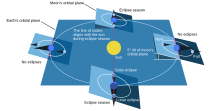
Back Volmaan Afrikaans بدر Arabic Lluna enllena AST بدر (بوتون آی) AZB Поўня (фаза Месяца) Byelorussian Пълнолуние Bulgarian পূর্ণিমা Bengali/Bangla Lluna plena Catalan مانگی پڕ CKB Úplněk Czech


The full moon is the lunar phase when the Moon appears fully illuminated from Earth's perspective. This occurs when Earth is located between the Sun and the Moon (when the ecliptic longitudes of the Sun and Moon differ by 180°).[3] This means that the lunar hemisphere facing Earth—the near side—is completely sunlit and appears as an approximately circular disk. The full moon occurs roughly once a month.
The time interval between a full moon and the next repetition of the same phase, a synodic month, averages about 29.53 days. Therefore, in those lunar calendars in which each month begins on the day of the new moon, the full moon falls on either the 14th or 15th day of the lunar month. Because a calendar month consists of a whole number of days, a month in a lunar calendar may be either 29 or 30 days long.
- ^ "'Super Moon' ExceptIonal Brightest Moon in the Sky of Normandy, Monday, November 14". silvertimes.com. 12 November 2016. Archived from the original on 27 April 2020. Retrieved 8 February 2017.
- ^ "Moongazers Delight — Biggest Supermoon in Decades Looms Large Sunday Night". 10 November 2016. Archived from the original on 27 April 2020. Retrieved 27 February 2017.
- ^ [P. Kenneth Seidelmann (ed.), "Phases of the Moon", Explanatory Supplement to the Astronomical Almanac: A Revision to the Explanatory Supplement to the Astronomical Ephemeris and the American Ephemeris and Nautical Almanac, (Mill Valley: University Science Books, 1992), p. 478.
© MMXXIII Rich X Search. We shall prevail. All rights reserved. Rich X Search